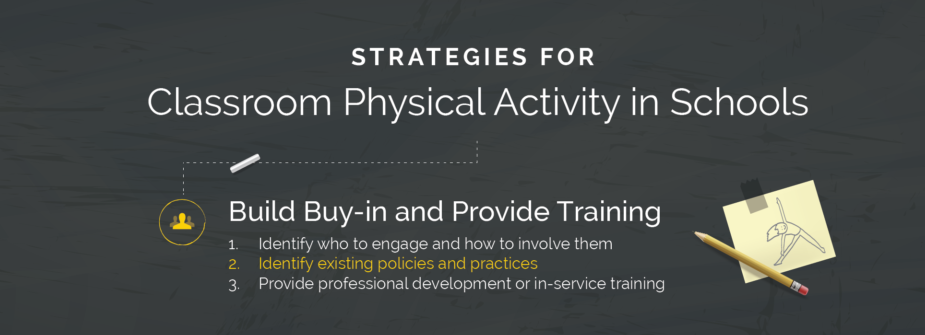Identify what classroom physical activity policies and practices currently exist.
Policies that address classroom physical activity may already exist at state, district, and school levels. State policies that require students to engage in a certain amount of physical activity every day are effective at promoting regular activity. All districts that participate in school meals programs (such as the National School Lunch Program) are required to have local wellness policies that include physical activity goals and to make these policies publicly available.
School staff can review local school wellness policies and relevant district policies to see if they have requirements for school-based physical activity overall or classroom physical activity specifically. Examples include policies that require regular classroom physical activity or that require schools to report the number of daily minutes of activity. If such policies exist, schools can consider ways to use these policies to make the case for initiating, strengthening, and expanding classroom physical activity practices.
If no policies exist at state, district, or school levels, schools may be able to identify specific classroom physical activity practices that can be replicated or expanded. They can also use CDC’s School Health Index to assess and strengthen their policies and practices related to physical education and physical activity. Assessment results can be used to create an action plan to include physical activity in the school’s mission and integrate classroom physical activity into existing or new school policies and practices to help make it part of the school culture.
Citations can be found in Strategies for Classroom Physical Activity in Schools.
Key Activities
Put Strategy 2 into practice through the following activities:
✓ Identify if your state, district, or school currently has classroom physical activity policies in place.
Possible sources include:
- The Shape of the Nation Report,
- District school wellness policies,
- School handbook,
- State education board policies, and
- State laws.
✓ Determine if policies and practices are aligned with the national guidance on classroom physical activity, outlined in Strategies for Classroom Physical Activity in Schools.
✓ Determine if any assessments have been completed to guide current classroom physical activity policies and practices.
✓ Identify approaches to strengthen classroom physical activity policies and practices, as appropriate.
Questions for Consideration
Use the following questions to guide key activities and inspire new ideas:
For policies
For practices
For assessments
Resource
National Guidance for Classroom Physical Activity Assessment
Use this worksheet to help identify alignment of policies and practices with the national guidance on classroom physical activity.
Leverage Policy to Activate Classroom Physical Activity Practice – A story from Vermont
Use state policies to build buy-in for classroom physical activity – A story from South Carolina
National Guidance for Classroom Physical Activity Assessment (Springboard to Active Schools)
This worksheet can be used to plan for “Strategy 2: Identify what classroom physical activity policies and practices currently exist.” Use this worksheet to help identify alignment of policies and practices with the national guidance on classroom physical activity.
Active Schools Toolkit (Wisconsin Department of Public Instruction, Toolkit)
- Pages 9-14 – Describes how to conduct an assessment of current policies/practices related to physical activity and/or how to use existing data. While this resource addresses physical activity in schools generally, these concepts can be applied to classroom physical activity, specifically.
- Pages 116-127 – Sample checklists to evaluate current policies and practices related to physical activity in schools.
Pages 16-20 – Provides a pre-initiative needs assessment, school survey, and maintenance/evaluation survey. Select items from this assessment to help you create your own assessment for classroom physical activity.
Pages 2-3 – Lists policies that could be used to support classroom physical activity (e.g., school wellness policy, dress and appearance policy, etc.).
Page 8 – A continuum of policy language examples for physical activity in secondary classrooms.

